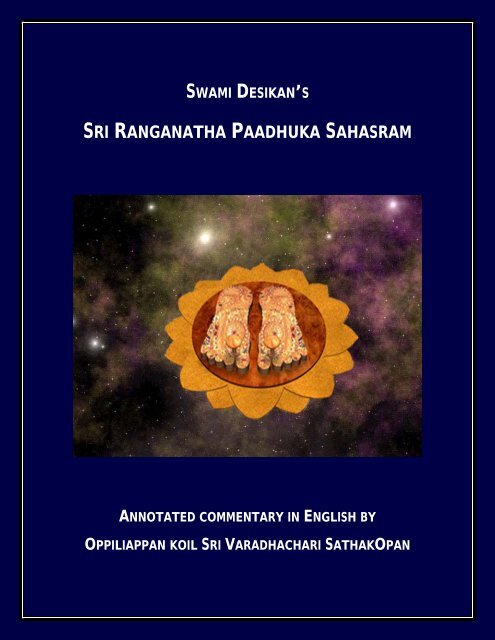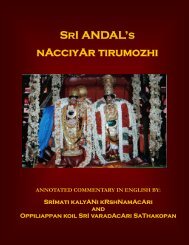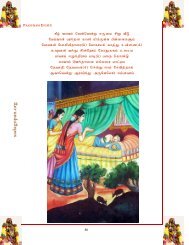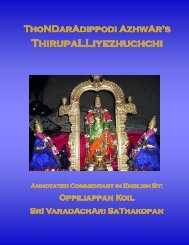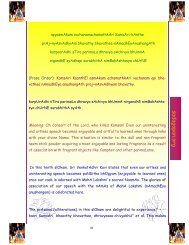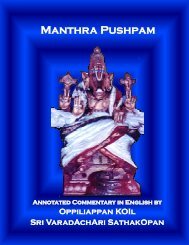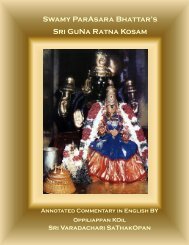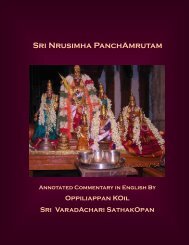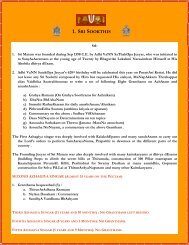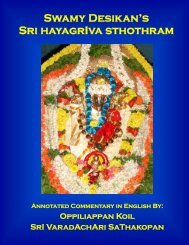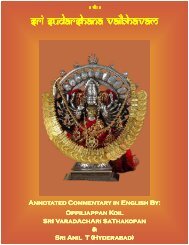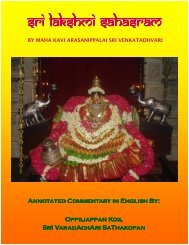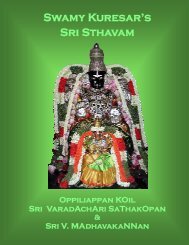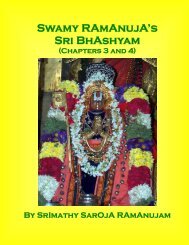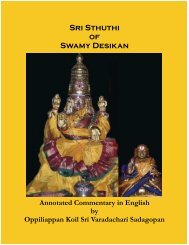SRI RANGANATHA PAADHUKA SAHASRAM - Sundarasimham
SRI RANGANATHA PAADHUKA SAHASRAM - Sundarasimham
SRI RANGANATHA PAADHUKA SAHASRAM - Sundarasimham
You also want an ePaper? Increase the reach of your titles
YUMPU automatically turns print PDFs into web optimized ePapers that Google loves.
Sri<br />
SWAMI DESIKAN’S<br />
<strong>SRI</strong> <strong>RANGANATHA</strong> <strong>PAADHUKA</strong> <strong>SAHASRAM</strong><br />
ANNOTATED COMMENTARY IN ENGLISH BY<br />
OPPILIAPPAN KOIL <strong>SRI</strong> VARADHACHARI SATHAKOPAN<br />
i
Sri<br />
ANNOTATED COMMENTARY IN ENGLISH BY<br />
OPPILIAPPAN KOIL <strong>SRI</strong> VARADHACHARI SATHAKOPAN<br />
ii
Sri<br />
TABLE OF CONTENTS –<br />
Paddhathi SlOkams Explanation Pages<br />
Introduction i-xii<br />
Prasthaava Paddhathi 1-20<br />
SamAkhya Paddhathi 21-30<br />
Introduction to the PaadhukA<br />
Sahasram<br />
How Paaduka is appropriately<br />
referred to as Sataari or Satakopam<br />
1-17<br />
18-25<br />
Prabhava Paddhathi 31-100 Greatness of Paaduka 26-73<br />
Samarpana Paddhathi 101-120<br />
PrathiprasthAna Paddhathi 121-140<br />
AdhikAra Parigraha<br />
Paddhathi<br />
Rama had pledged Paaduka to<br />
Bharata as surety for return<br />
Return of Paaduka to Ayodhya with<br />
Bharata<br />
74-88<br />
89-102<br />
141-180 Assumption of Power 103-127<br />
Abhisheka Paddhathi 181-210 Coronation of the Paaduka 128-147<br />
NiryAthanA Paddhathi 211-240<br />
VaithALikA Paddhathi 241-250<br />
SrungAra Paddhathi 251-260<br />
SanchAra Paddhathi 261-320<br />
Reinstatement at Rama's feet after<br />
14 years<br />
Poets and Panegyrists sing Paaduka's<br />
praise<br />
Love-play between Paaduka Devi<br />
and Lord Rama<br />
The Lord strolls with the Paadukas<br />
on<br />
148-167<br />
168-175<br />
176-182<br />
183-221<br />
Pushpa Paddhathi 321-350 Oblations with flowers 223-238<br />
ParAga Paddhathi 351-380 Potency of dust from the Paadukas 239-255<br />
Naadha Paddhathi 381-480 On the melody of Paaduka walking 256-315<br />
Rathna SaamAnya<br />
Paddhathi<br />
Bahurathna Paddhathi 531-580<br />
481-530 Gems as a totality-Distant view 316-345<br />
Varieties of gems present together<br />
emitting spectra-Near view<br />
346-376<br />
iii
Paddhathi SlOkams Explanation Pages<br />
PadmarAga Paddhathi 581-610 The luster of the ruby 377-392<br />
MukthA Paddhathi 611-660 On pearls in the Paaduka 393-422<br />
Marathaka Paddhathi 661-680 On the emerald gems 423-435<br />
Indra Neela Paddhathi 681-710 On the sapphire beauty 436-454<br />
BimBha PrathibimBha<br />
Paddhathi<br />
711-730<br />
Sri<br />
Objects reflected in the Paadukas<br />
lustrous surface<br />
455-468<br />
Kaanchana Paddhathi 731-750 Gold Paadukas 469-483<br />
Sesha Paddathi 751-760<br />
Paaduka exhibiting its status of<br />
subservience. Also the incarnation<br />
of Adisesha<br />
484-490<br />
Dwandhva Paddhathi 761-780 The twin-Paaduka and its speciality 491-502<br />
Sannivesa Paddhathi 781-800 Shape and beauty of the Paaduka 503-516<br />
YanthrikA Paddhathi 801-810 The knob in each Paaduka 517-522<br />
RekhA Paddhathi 811-820 Of the streaks on the Paaduka 523-529<br />
SubhAshitha Paddhathi 821-830<br />
The maxims of conduct that the<br />
Paaduka implies<br />
530-536<br />
PrakeerNa Paddhathi 831-910 Miscellaneous aspects 537-593<br />
Chitra Paddhathi 911-950<br />
NirvEda Paddhathi 951-970<br />
Phala Paddhathi 971-1008<br />
Chitra Paddhati which emphasizes a<br />
suitable fitting matrix of artistry - a<br />
specialty of Oriental poetry<br />
Words in disgust, in humility;<br />
entreating about one's pitiable<br />
plight<br />
Rewards for having composed of the<br />
work and for recitation of the same<br />
594-638<br />
639-656<br />
657-687<br />
iv
Sri<br />
. ïI>.<br />
. ïImte ramanujay nm>.<br />
. ïImte ingmaNt mhadeizkay nm>.<br />
INTRODUCTION<br />
<strong>SRI</strong>MAN VENKATANAATHAARYA: KAVI THAARKIKA KESAREE i<br />
VEDHANTHAACHARYAVARYO MEH SANNIDHATATHAAM SADHAA HRUDHI ii<br />
In this multifaceted master-piece of a Kavyam of RPS, Swami Desikan has celebrated the<br />
glories of the two PAADHUKHAAS (sandals) adorning and supporting the lotus feet of the Lord of<br />
Srirangam. This suprasiddha (highly revered) kavyam has 1,008 verses housed in 32 chapters<br />
(Paddhathis). It is said that Swami Desikan composed all of these 1008 verses in one Yamam of<br />
a night in response to a challenge set by a Sr Sri RanganAtha PaadhukA Sahasram (RPS) is one of<br />
the most magnificent literary, philosophical and theological compositions of Swami Desikan.<br />
The other kAvyams such as Sankalpa SuryOdhayam, YaadhavAbhyudhayam, Hamsa Sandesam<br />
and Subhashitha Neevi have their unique merits. For instance, Sankalpa SuryOdhayam is an<br />
allegorical play, where the cardinal doctrines of SrivaishNavite philosophy are covered. The<br />
Hamsa Sandesam modeled very much after Mega Sandesam of the immortal bard KaaLidAsA ,<br />
the literary and poetic talents as well as his knowledge of the Indian subcontinent of Swami<br />
Desikan come to the fore. In his kAvyam on the life and history of Sri KrishNA-- the Yadhava<br />
kula Tilakam --known as YaadhavAbhyudhayam, Swami celebrated the scion of the Yadhu<br />
kulam. The Subhashitha neevi is a "didactic lyric" containing the wise and pithy statements<br />
similar to the ones found in the Niti Sataka of poet Bharthruhari. The uniqueness of PadhukhA<br />
Sahasram is that it is an intgrated essence of the literary, poetic, philosophical and theological<br />
and last but not the least, the Bhakthi of Swami Desikan at its full bloom.<br />
A SrivaishNava of Srirangam challenged Swamy Desika and suggested that whoever completes<br />
1,000 slokams on ANY subject of his choice in ONE NIGHT will be the winner of the title as the<br />
MahA Kavi. Swami Desikan was least interested in acquiring the title or entering into a<br />
competition with the ego-driven local poet/ SrivaishNavA of Srirangam. He accepted however<br />
this challenge as a command of Sri RanganAthA for him to compose a eulogy on HIS anantha<br />
KalyANa guNams. Swami chose the subject of the sandals of the Parama Purushan of Srirangam<br />
and created the 1,008 verses celebrating their glories. The competitor chose the subject of the<br />
Paadha Kamalam of Sri Ranganatha and barely completed 300 verses during the course of the<br />
night and gave up his futile attempt. During the next morning, Swami Desikan presented to the<br />
Lord of Srirangam his grantham entitled, “Sri Ranganatha PadhukhA Sahasram” at the temple<br />
and was duly honored by the scholars and devotees assembled there and most importantly<br />
received the blessings of the Lord Himself.<br />
According to another version, Swami Desikan settled down in Srirangam after many years of<br />
residence at Thiruvaheendrapuram and was engaged in the SiddhAntha Pravachanam to his<br />
disciples. His MedhA vilasam and brilliance in interpreting Bhagavadh RaamAnuja SiddhAntham<br />
was admired by the residents of Srirangam. A group of scholars appealed to Swami Desikan at<br />
this time to compose an Uttama Kaavyam on the Lord of Srirangam to celebrate the unmatched<br />
devotion of their AcharyA to Periya PerumAL. Swami Desikan accepted their wish as the Lord's<br />
command and composed the bhakthi-laden verses of Sri Ranganatha PadhukhA Sahasram (RPS).<br />
In that extraordinary kaavyam, he explained that the Lord's sandals and NammAzhwAr are one<br />
and the same. He pointed out further that the sacred sound arising from the movement of the<br />
Lord on His padhukhAs is equal to the sacred sound of Thiruvaimozhi arising out of Sri<br />
SatakOpA's mouth and RPS emanating out of his own mouth.<br />
v
Sri<br />
The individual verses arising from the power of Swami Desikan's Hayagreeva mantrOpAsanam<br />
are very powerful in their mAntric significance. The Andavans of Srirangam, who worship the<br />
MaNi PaadhukhAs of Sri RanganAthA in their daily AarAdhanam have identified individual<br />
slokAs for japam and DhyAnam to realize specific siddhis. The Lifco Company of Madras has<br />
produced a small monograph on the individual slokams with such maantric significance and has<br />
given the sankalpams for the japam of these slokams of RPS with the guidance of the Andavans<br />
of Srirangam. This booklet also contains the yantrams with bheejAksharams at the center for<br />
the ladies of the house to draw in the pujA grahams of their houses as kolams (RangOlis) as the<br />
accompaniment to the japam and to invoke (aavAhanam) of the Lord wearing His sandals (Lord<br />
and NammAzhwAr) on individual days of the week. There have been repeated<br />
demonstrations of the siddhis arising out of such japams of the individual<br />
slokams of RPS in many people's lives. People performing Mantra japam of<br />
individual slokams have attained the fruits of their efforts to achieve loukika<br />
and Vaidhika purushaarthams. In essence, RPS is a celebration of one's AcharyAs and<br />
the celebration of the acharya-bhagavadh sambhandham. It is therefore a PaarayaNa grantham<br />
like Srimadh RaamAyaNam of sage Valmiki. When one does PaarAyaNam of RPS, one enjoys the<br />
Lord of Srirangam directly (pratyakhshamiva Samvruddham). When we recite the hundred<br />
slokAs of the chapter of RPS (paddhathi) known as Naadha Paddhathi with devotion, the<br />
Ranganatha sevakA can experience literally the “GathAgathAni " (the hither and thither<br />
Sancharam) of the bell-studded padhukhAs of the Lord of Srirangam. The most beautiful sounds<br />
of his sanchaAram as the Lord leave His aasthAnam in Srirangam and coming to our Puja<br />
Grahams have been captured by Swami Desikan. One experiences the different mellifluent<br />
sounds of the Lord's bell-studded PaadhukAs as His Paadam Thaangis (Periya and Siriya<br />
Thiruvadis) carry him on their back and engage in the steps used in transporting Him known as<br />
Simha Gathi, vyAgra gathi and others.<br />
THIRUVAIMOZHI AND <strong>RANGANATHA</strong> <strong>PAADHUKA</strong> <strong>SAHASRAM</strong><br />
Swami Desikan has closely modeled RPS after NammAzhwAr's Thiruvaimozhi with its 100<br />
decade. In view of the importance of RPS to us, Therezhundhur Aandavan created a Tamil<br />
commentary for us. He completed the commentary upto 860 slokams and could not continue<br />
further due to his illness. He commissioned then Sri Aakkur Andavan to complete the work. The<br />
year was 1955 and the extremely valuable commentary along the Andavan tradition was<br />
released in that year. For many years thereafter, this monograph was out of print. Thanks to<br />
the efforts of the disciples of Aandavan, this sacred monograph was re-released in 1995 in two<br />
parts. Sri Uttamur Swami had released his own VyAkhyAnam on RPS earlier and it is also out of<br />
print now. I was blessed to receive in 1994 the last copy of this brilliant commentary of RPS<br />
from the son-in-law of Uttamur SwamigaL (Sri K.G.KrishNan) at Madras. I had the good fortune<br />
to translate this version into english in 1995. This English version may be released in 1997 with<br />
the help of Sri K.G.KrishNan and Swami Desikan scholars such as Sri V.N.Vedantha Desikan, the<br />
author of "AzhwAr ThiruvuLLam” and Dr. S. PadmanAbhan, the author of Parasara Bhattar's<br />
works and a descendant of the ThevanaarviLagam Jeeyar of Ahobila Mutt. I am now bridging<br />
the two traditions of commentaries - that of Uttamoor SwamigaL and Srirangam Aandavans --<br />
so that we can appreciate the integrated essence of the two schools offering their devotion to<br />
Sri Ranganatha Divya MaNi PaadhukhAs.<br />
I will summarize in the next few postings the architectonics of RHS and the brief summary of<br />
the subject matter of the 32 paddhathis of RPS.<br />
In this posting, I will start with a salutation to THE ILLUSTRIOUS GLORY OF <strong>SRI</strong>RANGAM, the<br />
abode of Sriranganatha and His inseparable consort, Sri RanganAyaki. For illustrating the<br />
incomparable glory of the abode of the Lord, we can take Swami Desikan's own citation in<br />
Sanchara Paddhathi of RPS. In this paddhathi, Swami Desikan enjoys the uthsavams of Sri<br />
Ranganatha from viswarupa darsanam to paryankAsanam (i.e), from suprabhAtham<br />
vi
Sri<br />
(ThiruppaLLiyezucchi) to the Lord being sung to sleep at night. The particular slokam of<br />
Sanchara Paddhathi extolling the glories of Srirangam is the 312th slokam of RPS:<br />
satyAlokAth sakalamahithAth sthanathO vaa RaghUNAm<br />
sankhE maatha: ! samadhikaguNam saikatham sahyajAyA : I<br />
poorvam poorvm chiraparichitham paadhukE ! yath tyajanthyA<br />
neethO naathastadhithamitharanneeyathE na tvayAasou II<br />
Meaning: O PaadhukE! You brought BhagavAn first from Sri VaikunTam to Satya Lokam, the<br />
world of BrahmA Devan. Then you brought Him over to the house of Raghus at AyodhyA.<br />
Thereafter, you carried Him to Srirangam. He has not ventured out anywhere else since arriving<br />
at Srirangam on Your back. Therefore, I conclude correctly that there is no place superior to<br />
Srirangam.<br />
RAJA GOPURAM OF <strong>SRI</strong>RANGAM<br />
ADDITIONAL GLORIES OF <strong>SRI</strong>RANGAM<br />
Srirangam is indeed the Divya Desam<br />
celebrated by 11 AzhwArs through 247<br />
pAsurams of the NaalAyira Divya Prabhandham.<br />
This is where AndAL, Kulasekhara AzhwAr,<br />
Tondardipodi, ThiruppAnAzhwAr, YatirAjar<br />
joined the Lord. AndAL and ThiruppANAzhwAr<br />
merged with the Lord in person; the rest<br />
ascended to Sri VaikunTam at this Divya<br />
Desam. Periya Nambi, ParAsara Bhattar,<br />
Vadakku Thiruveedhi PiLLai, Pillai LokAcchAr,<br />
his brother and author of Acharya Hrudhayam<br />
and many other AcharyAs were born here.<br />
AcharyAs like NathaMuni, AalavandhAr Swami<br />
Desikan, MaNavAla MaamunigaL and other<br />
Acharya PurushAs lived here and offered their<br />
worship to Sri RanganathA and His PaadhukhAs.<br />
IMPORTANCE AND GLORY OF ACHARYAS<br />
In our tradition, the Lord's Paadhukais are considered identical to Acharyan and<br />
particularly, NammAzhwAr, who is revered as SatAri Suri. The PadhukhAs are HENCE known<br />
as "Satakopam" and is placed on our heads at the sannidhis of BhagavAn to remind us of the<br />
Acharya Sambhandham. It is our deep belief that a Jeevan can attain sathgathi only through<br />
the strength and power of one's Acharya. The definition of an Acharyan is accepted by us as<br />
follows:<br />
vii
Sri<br />
" Nalla sangathikaLai arindhu, anthappadi nadanthu, appadiyE pirarukkum therivitthu, nadatthi<br />
vaikkiravan " (One who understands the right messages form his acharyAs, practices them,<br />
interprets and passes them on to his own disciples). The practice of AchAram, AnushtAnam and<br />
helping others to understand them through personal example and uniting us with the Lord<br />
through the power of their own Tapas are the hall marks of a sadhAcharyan. Swami Desikan has<br />
covered the extraordinary and unique role of AcharyAs in his 32nd (final) chapter of his Rahasya<br />
traya Saaram to emphasize these doctrines.<br />
NAMAAZHWAAR<br />
THE IMPORTANCE OF NAMAAZHWAAR IN OUR TRADITION<br />
It is well known that it is very difficult to obtain a<br />
SadhAcharyan. The SEQUENCE OF STEPS leading to<br />
Bhagavadh Anugraham are recognized to be: SadhAcharya<br />
KatAksham, SadhAchArya anugraham (PrasAdham),<br />
Bhagavadh Anugraham, Moksham.<br />
Swami Desikan emphasised like the SadAchAryas before<br />
and after him that the attainment of Sadhgathi by the<br />
Jeevans is due to the strength and power of the AchAryAs<br />
and sambhandham with those AchAryAs. At his very end of<br />
his Magnum opus, Rahasya Traya Saaram, Swami Desikan<br />
concluded therfore “manyE Balam ". We have to<br />
understand and revere the Guru paramparA (Acharya<br />
VamsO j~nEya:) for that reason .<br />
The first Acharyan in our tradition is <strong>SRI</strong>MAN NARAYANAN,<br />
THE SARVESWARAN. He lights the eternally shining lamp of<br />
sampradhAyam and illumines the mind of the next<br />
Acharyan. Through a line of succesion, NammAzhwAr or Thirukkuruhoor Satakopan occupies a<br />
key place in our Acharya paramparai. He is celebrated as the Prapanna Jana kutasthar and our<br />
Kula pathi (founder-seer). He himself has stated in his Periya ThiruvandhAdhi (paasuram 31)<br />
that "By becoming servants of the Lord, we have verily become as it were HIS sacred sandals<br />
(paadhukhAs)". THAT IS OUR KEY REVELATION ON NAMMAZHWAR BEING CONSIDERED AS<br />
THE PADHUKAI OF THE LORD AT <strong>SRI</strong>RANGAM. Swami Desikan elected therefore to celebrate<br />
the Padhukais of the Lord of Srirangam instead of the Lord's Lotus feet themselves.<br />
In the subsequent postings, the summaries of the 32 chapters of RPS of Swami Desikan will be<br />
given and illustrative verses from each of the Paddhathis will be included.<br />
In this posting, I will begin to cover the individual chapters of RPS of Swami Desikan. There are<br />
32 chapters in RPS just as in the case of Rahasya Traya Saaram. The context of the 32 chapters<br />
of RPS by Swami Desikan is to the 32 Brahma VidyAs celebrated by the upanishads. Prapatthi is<br />
one of these 32 Brahma Vidyas and RPS is ALL about this particular Brahma Vidya.<br />
The names of the Individual chapters and the number of slokams housed in these Paddhathis<br />
(chapters/Vazhi/Maargam) in parenthesis are:<br />
1. PrasthAva paddhathi( 20 )<br />
2. SamAkhyA paddhathi ( 10 )<br />
3. PrabhAva Paddhathi ( 100 )<br />
4. SamarpaNa Paddhathi ( 20 )<br />
viii
5. PrathiprasthAna Paddhathi ( 20 )<br />
6. AdhikAra Parigraha Paddhathi ( 40 )<br />
7. Abhisheka Paddhathi ( 30 )<br />
8. NiryAthanA paddhathi( 30 )<br />
9. VaithALikA paddhathi (10 )<br />
10. SrungAra Paddhathi ( 10 )<br />
In the middle of the above Paddhathi, Swami Desikan completes the first quartile of RPS.<br />
11. SanchAra Paddhathi ( 60 )<br />
12. Pushpa Paddhathi ( 30 )<br />
13. ParAga Paddhathi ( 30 )<br />
14. Naadha Paddhathi (100 )<br />
15. Rathna SaamAnya Paddhathi ( 50 )<br />
Sri<br />
In the middle of the above Paddhathi, Swami Desikan reaches the halfway point of His 1008<br />
Slokams of RPS. He has by now reached the half way mark of the Yaamam of the night at<br />
Srirangam.<br />
16. Bahurathna Paddhathi ( 50 )<br />
17. PadmarAga Paddhathi ( 30 )<br />
18. MukthA Paddhathi ( 50 )<br />
19. Marathaka Paddhathi ( 20 )<br />
20. Indra Neela Paddhathi ( 30 )<br />
21. BimBha PrathibimBha paddhathi ( 20 )<br />
22. Kaanchana Paddhathi ( 20 )<br />
23. Sesha Paddhathi ( 10 )<br />
In the middle of Sesha Paddhathi, Swami Desikan racing against time reached the third quarter<br />
of the RPS and is poised to enter the most important home stretch.<br />
24. Dwandhva Paddhathi ( 20 )<br />
25. Sannivesa Paddhathi ( 20 )<br />
26. YanthrikA paddhathi ( 10 )<br />
27. RekhA Paddhathi ( 10 )<br />
28. SubhAshitha Paddhathi (10 )<br />
29. PrakeerNa Paddhathi ( 80 )<br />
30. Chitra Paddhathi ( 40 )<br />
31. NirvEda Paddhathi ( 20 )<br />
32. Phala Paddhathi ( 38 )<br />
In the very last slokam of PaadukhA Sahasram, Swami Desikan with His extraordinary sense of<br />
focus and purpose reminds us of the central message of His Sri Ranganatha PadhukhA Sthotram<br />
(VIZ)., SadhAcharya, Bhagavadh Sambhandham and the doctrine of us being married into the<br />
ROYAL FAMILY and the glory of the everlasting purushArtham, Moksham through the DayA of<br />
NamperumAL and the AnukampA of Sri Ranganayaki for us as their beloved children.<br />
I will conclude this posting with the quotation of the FIRST AND LAST last slokam of RPS:<br />
SLOKAM 1:<br />
SANTHA: <strong>SRI</strong>RANGAPRUTHVEESA<br />
SARANA THRAANA SEKHARAA: I<br />
ix
Sri<br />
JAYANTHI BHAUVANATHRAANA<br />
PADHA PANKAJA RENAVA: II<br />
SLOKAM 1,008:<br />
JAYATHI YATHIRAAJASOOKTHI:<br />
JAYATHI MUKHUNDASYA PADHUKHAA YUGALEE I<br />
TADHUBHAYA DHANAA: TRIVEDHEEM<br />
AVANDHYAYANTHO JAYANTHI BHUVI SANTHA: II<br />
The sense of symmetry and the unity in the first and the last slokams and for that matter<br />
across the length of RPS has no parallel. The start with the word Santha: and the ending with<br />
the same word, Santha: and the singing of Pallandu to those SanthAs with the words Jayanthi<br />
and Jayathi at the beginning and the ending of RPS is another great pointer to the centrality of<br />
the message of RPS on the BhagavathAs and their victory in obtaining the object of their<br />
endeavours (viz)., SadhAcharya Sambhandham and the marriage with the Lord of Srirangam<br />
through the anugraham of SatAri Suri, the Kula pathi for PrapannAs.<br />
“santha: SrinigamAnthaArya sambhavithasuvrutthaya : I<br />
sahanthAm saahasam teevram suhruthbhAvEna maamakam II "<br />
SrimathE NigamAntha MahAdesikAya Nama: II<br />
|| Sriranganaatha divya MaNi PaadhukhAbhyAm Nama: ||<br />
x
Sri<br />
Sri Ranganatha Paadhuka Sahasram, 1008 SlOkams of this magnificent work by Swami Desikan<br />
are set in 32 Paddhathis. The Paddhathis are organized as follows. (This is reproduced from U.<br />
Ve. Sri Vedanta Desikan Swamin's book). The brief meanings of the individual slOkams that follow<br />
immediately after the slOkams have been reproduced from Dr.V.N. Vedantha Desikan's<br />
monograph with the help of Dr. MuraLidhar Rangaswamy of Bangalore.<br />
The breakup of Sri Ranganatha Paadhuka Sahasram's 1008 SlOkams in 32 Paddhathis is as<br />
follows:<br />
Name of the Paddhathi SlOkams Content of the Paddhatis<br />
1. Prasthaava paddhathi Verses 1-20<br />
2. SamAkhyA paddhathi Verses 21-30<br />
Introduction to the PaadhukA<br />
Sahasram<br />
How Paaduka is appropriately<br />
referred to as Sataari or Satakopam<br />
3. PrabhAva Paddhathi Verses 31-100 Greatness of Paaduka<br />
4. SamarpaNa Paddhathi Verses 101-120<br />
5. PrathiprasthAna Paddhathi Verses 121-140<br />
6. AdhikAra Parigraha<br />
Paddhathi<br />
Rama had pledged Paaduka to<br />
Bharata as surety for return<br />
Return of Paaduka to Ayodhya with<br />
Bharata<br />
Verses 141-180 Assumption of Power<br />
7. Abhisheka Paddhathi Verses 181-210 Coronation of the Paaduka<br />
8. NiryAthanA paddhathi Verses 211-240<br />
9. VaithALikA paddhathi Verses 241-250<br />
10. SrungAra Paddhathi Verses 251-260<br />
11. SanchAra Paddhathi Verses 261-320<br />
Reinstatement at Rama's feet after<br />
14 years<br />
Poets and Panegyrists sing<br />
Paaduka's praise<br />
Love-play between Paaduka Devi<br />
and Lord Rama<br />
The Lord strolls with the Paadukas<br />
on<br />
12. Pushpa Paddhathi Verses 321-350 Oblations with flowers<br />
13. ParAga Paddhathi Verses 351-380 Potency of dust from the Paadukas<br />
14. Naadha Paddhathi Verses 381-480 On the melody of Paaduka walking<br />
15. Rathna SaamAnya<br />
Paddhathi<br />
Verses 481-530 Gems as a totality-Distan view<br />
xi
Sri<br />
16. Bahurathna Paddhathi Verses 531-580<br />
Varieties of gems present together<br />
emitting spectra-Near view<br />
17. PadmarAga Paddhathi Verses 581-610 The luster of the ruby<br />
18. MukthA Paddhathi Verses 611-660 On pearls in the Paaduka<br />
19. Marathaka Paddhathi Verses 661-680 On the emerald gems<br />
20. Indra Neela Paddhathi Verses 681-710 On the sapphire beauty<br />
21. BimBha PrathibimBha<br />
paddhathi<br />
Verses 711-730<br />
22. Kaanchana Paddhathi Verses 731-750 Gold Paadukas<br />
23. Sesha Paddhathi Verses 751-760<br />
Objects reflected in the Paadukas<br />
lustrous surface<br />
Paaduka exhibiting its status of<br />
subservience. Also the incarnation<br />
of Adisesha<br />
24. Dwandhva Paddhathi Verses 761-780 The twin-Paaduka and its speciality<br />
25. Sannivesa Paddhathi Verses 781-800 Shape and beauty of the Paaduka<br />
26. YanthrikA paddhathi Verses 801-810 The knob in each Paaduka<br />
27. RekhA Paddhathi Verses 811-820 Of the streaks on the Paaduka<br />
28. SubhAshitha Paddhathi Verses 821-830<br />
The maxims of conduct that the<br />
Paaduka implies<br />
29. PrakeerNa Paddhathi Verses 831-910 Miscellaneous aspects<br />
30. Chitra Paddhathi Verses 911-950<br />
31. NirvEda Paddhathi Verses: 951-970<br />
32. Pala Paddhathi Verse 971-1008<br />
Chitra Paddhati which emphasizes a<br />
suitable fitting matrix of artistry - a<br />
specialty of Oriental poetry<br />
Words in disgust, in humility;<br />
entreating about one's pitiable<br />
plight<br />
Rewards for having composed of<br />
the work and for recitation of the<br />
same<br />
|| Sriranganaatha divya MaNi PaadhukhAbhyAm Nama: ||<br />
kivtaikRk is.<br />
kavitaarkika siMhaaya kalyaaNa guNa shaaline.<br />
shrImate ve~NkaTeshaaya vedaanta gurave namaH.<br />
xii


